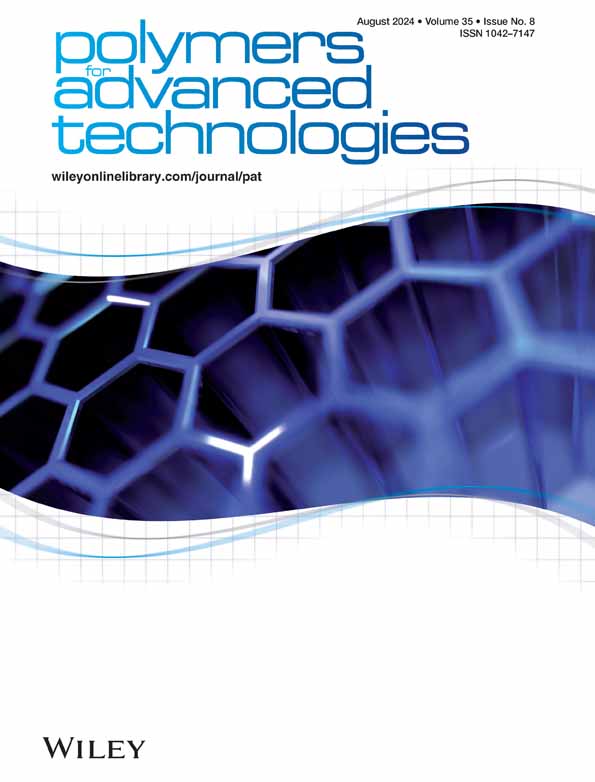光学透明压敏胶含柔性交联剂,具有高恢复效率、低储能模量和出色的耐折性
IF 3.4
4区 工程技术
Q2 POLYMER SCIENCE
引用次数: 0
摘要
光学透明压敏胶(OCA)具有优异的光学性能和压敏粘合性,因此被广泛应用于各种电子显示设备的粘合层。然而,近年来可折叠手机的日益普及对 OCA 的整体性能提出了新的要求。传统的压敏粘合剂可以通过交联提高可回收性,但往往粘合强度不足。本研究使用丙烯酸羟乙酯(HEA)、二环己基甲烷二异氰酸酯(HMDI)、聚丙二醇(PPG)、聚醚胺(PEA)和羟基封端聚丁二烯(R45V)合成了三种长链交联剂(CL)。长链 CL 剂包含许多柔性段,可提高光学透明压敏胶的恢复能力,同时保持一定的粘附性。由三种柔性交联剂交联而成的光学透明压敏胶具有较低的玻璃化转变温度(-60 至 -40°C)和较低的储存模量(0.1 兆帕),以及适当的 180° 剥离力(6-8 牛/25 毫米)。光学透明压敏胶具有出色的恢复性能(85%)、高透光率(92%)和超强的柔韧性。此外,与市场上的产品相比,光学透明压敏胶还具有卓越的耐折性(100,000 次)。这表明它适合应用于柔性光学显示器,如可折叠手机和可穿戴电子产品。本文章由计算机程序翻译,如有差异,请以英文原文为准。
Optically clear pressure‐sensitive adhesive with flexible crosslinking agent for high recovery efficiency, low energy storage modulus, and excellent folding resistance
Optically clear pressure‐sensitive adhesive (OCA) possesses exceptional optical properties and exhibits pressure‐sensitive adhesion, making it widely utilized in the adhesive layers of various electronic display devices. However, the increasing popularity of foldable mobile phones in recent years has imposed new requirements on the overall performance of OCA. Conventional pressure‐sensitive adhesives can enhance recoverability through cross‐linking but often demonstrate inadequate adhesive strength. In this study, three long‐chain crosslinking agents (CL) were synthesized using hydroxyethyl acrylate (HEA), dicyclohexylmethane diisocyanate (HMDI), polypropylene glycol (PPG), polyether amine (PEA), and hydroxyl‐terminated polybutadiene (R45V). The long‐chain CL agent contains numerous flexible segments that improve the recovery capability of the OCA while maintaining a certain level of adhesion. The optical clear pressure‐sensitive adhesive, crosslinked by three flexible crosslinkers, exhibits a low glass transition temperature (−60 to −40°C) and a low storage modulus (<0.1 MPa), along with an appropriate 180° stripping force (6–8 N/25 mm). Optically transparent pressure‐sensitive adhesives demonstrate excellent recovery properties (>85%), high light transmittance (>92%), and exceptional flexibility. Moreover, compared to market products, the optically transparent pressure‐sensitive adhesive shows superior folding resistance (>100,000 times). This indicates its suitability for applications in flexible optical displays such as foldable mobile phones and wearable electronics.
求助全文
通过发布文献求助,成功后即可免费获取论文全文。
去求助
来源期刊

Polymers for Advanced Technologies
工程技术-高分子科学
CiteScore
6.20
自引率
5.90%
发文量
337
审稿时长
2.1 months
期刊介绍:
Polymers for Advanced Technologies is published in response to recent significant changes in the patterns of materials research and development. Worldwide attention has been focused on the critical importance of materials in the creation of new devices and systems. It is now recognized that materials are often the limiting factor in bringing a new technical concept to fruition and that polymers are often the materials of choice in these demanding applications. A significant portion of the polymer research ongoing in the world is directly or indirectly related to the solution of complex, interdisciplinary problems whose successful resolution is necessary for achievement of broad system objectives.
Polymers for Advanced Technologies is focused to the interest of scientists and engineers from academia and industry who are participating in these new areas of polymer research and development. It is the intent of this journal to impact the polymer related advanced technologies to meet the challenge of the twenty-first century.
Polymers for Advanced Technologies aims at encouraging innovation, invention, imagination and creativity by providing a broad interdisciplinary platform for the presentation of new research and development concepts, theories and results which reflect the changing image and pace of modern polymer science and technology.
Polymers for Advanced Technologies aims at becoming the central organ of the new multi-disciplinary polymer oriented materials science of the highest scientific standards. It will publish original research papers on finished studies; communications limited to five typewritten pages plus three illustrations, containing experimental details; review articles of up to 40 pages; letters to the editor and book reviews. Review articles will normally be published by invitation. The Editor-in-Chief welcomes suggestions for reviews.
 求助内容:
求助内容: 应助结果提醒方式:
应助结果提醒方式:


